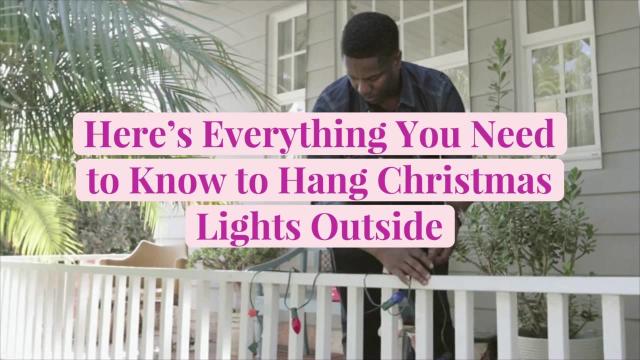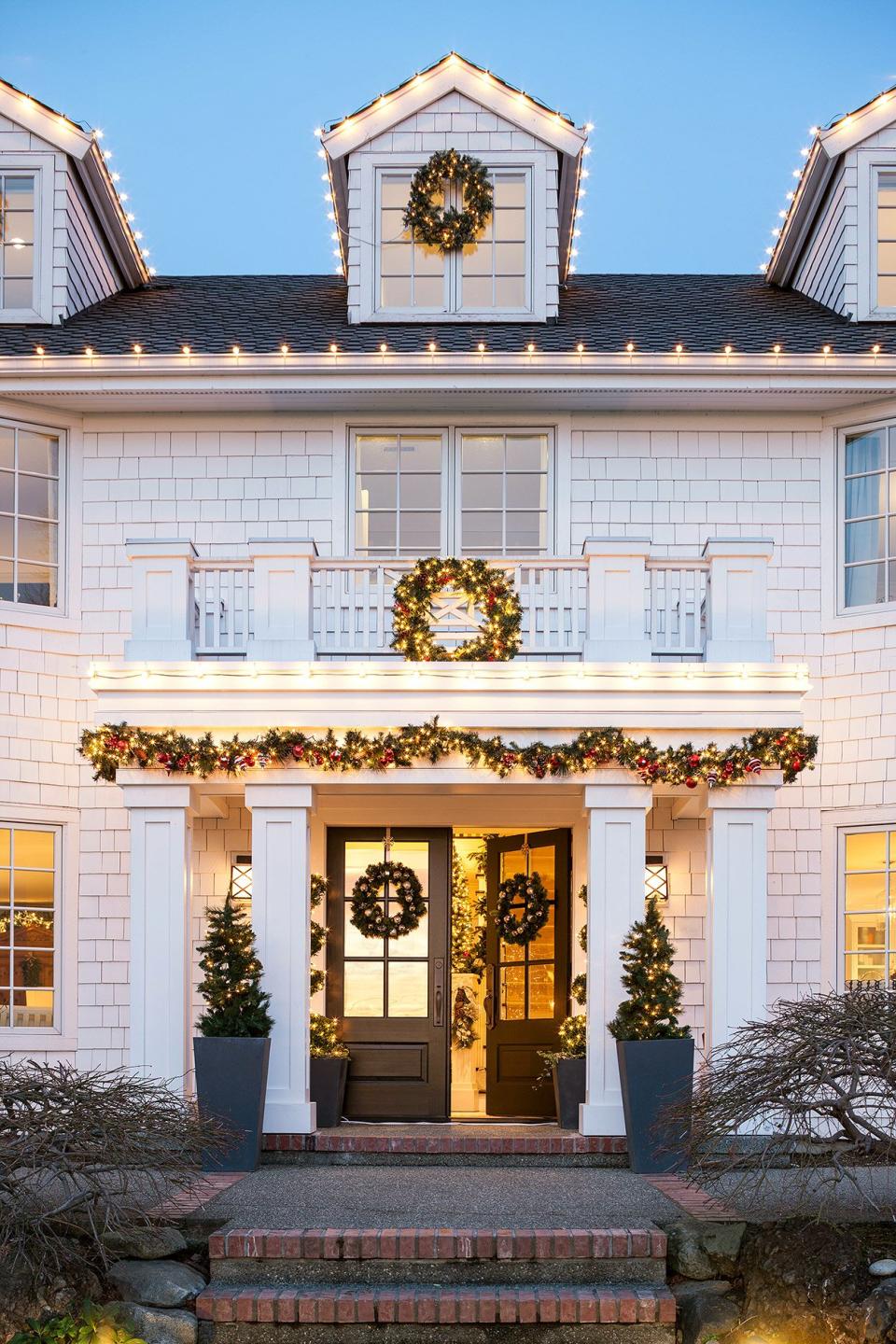How to Hang Outdoor Christmas Lights Like a Pro

Before you grab the ladder and start hanging Christmas lights, you need a plan for your winter wonderland—what type of Christmas lights you're going to hang, where you're going to drape them, and how you're going to secure them to the front of your house.
You also need to decide how large your display will be. You may just be executing an around-the-gutters-and-eaves operation, or you might want to consider something a little more intricate for your outdoor Christmas decorations. No matter how simple or complex, it helps to have a plan. Our step-by-step guide to DIY Christmas light hanging can help you develop a custom design that will work for every holiday season.
Related: 31 Ideas for the Best Christmas Decorations on the Block

andresr/Getty Images
The Difference Between Christmas Lights
There are dozens of varieties for Christmas string lights, so know the difference before you begin shopping. Icicle lights—like this white LED icicle light set ($20, The Home Depot)—come in large hanging curtains that will cover a lot of area. Other hanging lights come in specific shapes, like snowflakes, while traditional light strands create a uniform outline around the house.
Buy It: 70-Light LED Cool White Snowflake Icicle Light Set ($35, The Home Depot)
What kind of bulb matters, too. LED lights are more expensive than incandescent lights, but LED Christmas lights are designed to last longer—like tens of thousands of hours. The LED lights are more of an investment upfront, but they also help save energy on your holiday utility bill because of their efficiency. LED Christmas lights also tend to have more lights per string, which compensates for any reduction in brightness. They also tend to be whiter in color than incandescent lights which have a yellow tint. They're made of acrylic, which is harder to break. And LED lights are safer: they don't get hot to the touch, and you can connect 10 times more strings together, which means fewer extension chords.
T5 Mini bulbs are traditionally incandescent but are now available as an LED.
Wide Angle Mini bulbs cast light evenly, so it looks good from any angle. These are best used to wrap trees.
When looking at size, C7 light bulbs are smaller, traditional bulbs and C9 light bulbs are larger and easier to see from a distance. Both are popular for rooflines or around a big tree.
G12 round bulbs are the size of raspberries. This is a go-to if you want big points of light.
Dome bulbs create the effect of a mini flashlight beam.
Buy It: 100-Count LED Mini String Lights ($19, Target)

John Noltner
Tips for Measuring Your Home for Christmas Lights
Take one-time measurements of your home so you know how many Christmas lights you'll need. (There's nothing worse than hanging a string and realizing it only covers two-thirds of the intended space.) Then evaluate your power situation. Know where the outlets are and determine if you'll need to run exterior-grade extension cords from the outlet to the final destination where the Christmas lights will hang.
Editor's Tip: Plug in the string of lights before you start hanging Christmas lights outside so you can preview your work as you go—and you'll never end up with your light strand too far from an outlet!
Hanging Christmas Lights Safety Matters
Always consider safety when hanging Christmas lights around your home exterior. Ensure all extension cords ($20, Walmart) and light strings are in good condition and there are no exposed wires, broken sockets, or other safety hazards (and that they are made for outdoor purposes). When it comes to extension cords, the Electrical Safety Foundation International (ESFI) advises matching your power needs, or the amperage, of the lights to the amperage of the extension cords. (Check out their other smart safety tips, too).
The U.S. Consumer Product Safety Commission (CPSC) recommends not using more than three standard length strings of lights per one extension cord. (Check out the CPSC's brochure for more holiday safety tips.) As you are planning your lighting, ensure cords are kept away from snow and water and aren't tripping hazards, either. Work with a partner when hanging Christmas lights. You'll be surprised how much easier the process is with an extra set of hands, and it’s ideal to have a spotter while you’re on the ladder ($87, The Home Depot).
Related: How to Put Lights on a Christmas Tree Like a Pro

John Granen
How to Hang Christmas Lights Step-by-Step
Step 1: Pick a mild winter day and start hanging Christmas lights in the mid-morning while there is plenty of daylight left to burn.
Step 2: Layout all of your Christmas lights in the garage or another dry place and untangle any strings; test for burned-out bulbs. You can also do this step in the weeks before hanging the lights so there is plenty of time to replace dull Christmas lights.
Step 3: Inspect your ladder to make sure it's in good condition and opt for a wood or fiberglass ladder. The ESFI says metal ladders can conduct electricity, which is not a good thing when plugging in Christmas lights.
Step 4: Measure your home using our tips above to determine how many light strands you'll need. Make sure you have enough extra to plug in the lights once hung. When you’re ready to add Christmas lights to your house, start with the highest point and work your way from side to side and then down. Finish with railings, shrubs, and bushes.
Step 5: Be sure to secure your Christmas lights tightly but without damaging the wires. Avoid securing your Christmas lights with nails and staples because they increase the likelihood of ruining the wires. Determine what tools and hooks you need to hang the Christmas lights. Tabatha Wrisley of We Hang Christmas Lights, a professional Christmas light installation service, recommends using Omni clips ($7, Walmart). The clips clamp onto gutters, bricks or slide under roof shingles to hold bulbs in place easily. Another smart Christmas lighting pick? Power stakes. "Power stakes bring power closer to where you need it so you don't have to run cords all over your yard," Wrisley says. "For extra convenience, look for stakes with timers and remote controls." Once you’ve measured your home and know which lighting accessories you need, make a list (check it twice!) and start shopping.
Step 6: When you're done hanging Christmas lights, admire your handiwork! Lastly, don't forget to sync your Christmas light display with a timer, like this Outdoor Timer with Photocell Light Sensor ($25, The Home Depot), or unplug them before you go to bed.